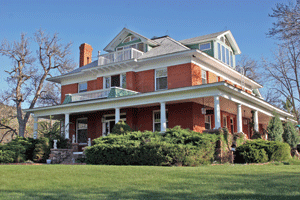Grill Skill: Your Guide to Grills
04 Jul 2007
Nothing says summer more than freshly grilled meals. Today’s portable gas grills have enough frills to turn even an amateur griller into a master.
Outdoor cooking has progressed since the days of dumping charcoal in a $20 hibachi, dousing it with lighter fluid and tossing in lit matches. Today’s portable gas grills sizzle with tasty fare and fashionably accent any landscape.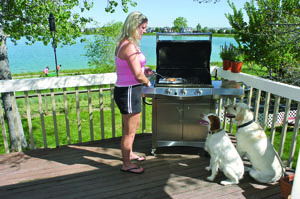 But is it worth spending from $200 to more than $5,000 for a grill to cook a $5 piece of chicken? Grill owners think so. “My kitchen is small and limits cooking for guests,” says Karenne Smith of Louisville. “Since we got our grill, we’ve been able to have more people over in summer.”
If you want to join the patio party, your options range from utilitarian grills to pricey models with extensive options. There’s a portable gas grill for every chef and yard. What’s the best one for you?
But is it worth spending from $200 to more than $5,000 for a grill to cook a $5 piece of chicken? Grill owners think so. “My kitchen is small and limits cooking for guests,” says Karenne Smith of Louisville. “Since we got our grill, we’ve been able to have more people over in summer.”
If you want to join the patio party, your options range from utilitarian grills to pricey models with extensive options. There’s a portable gas grill for every chef and yard. What’s the best one for you?
Size Matters
When grill shopping, the first consideration is who you will grill for. Smaller grills with less than 250 square inches of grilling surface are perfect for feeding a small family and a few guests. Midsized grills, from 250 to 500 square inches, can accommodate families and small parties. Large grills, over 500 square inches, have commercial capabilities for entertaining large parties. Then think about what you’re likely to cook on your grill. Steaks, chicken breasts and vegetables can be cooked in a small space, but large meat cuts, whole chickens, turkeys and briskets will require a large grill or a smoker. Larger grilling surfaces typically have more burners, each with independent flame adjustment. This advantage allows a chef to simultaneously prepare multiple dishes requiring different temperatures. Small grills have two burners, midsized models usually add a third, while the largest grills have at least four.Grills 101
The three primary grill materials— stainless steel, cast aluminum and porcelain-enameled steel—each have unique characteristics. Popular and shiny stainless steel continues to dominate high-end grills, but check for thickness, advises McGuckin Hardware manager Chris Nessel. “Thicker [stainless steel] is better because it’s less likely to warp from temperatures that can reach 650 degrees,” he says.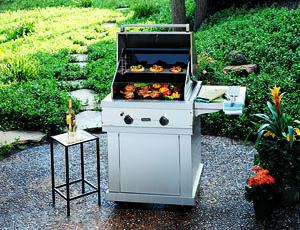 Most stainless-steel grills discolor, beginning with their first use, though they can be cleaned. A double-walled canopy—two pieces of stainless steel separated by air—can help prevent discoloration, says Mike Schildmeier of Boulder Valley Appliance. “But it makes the lid very heavy and hard to open,” he says. “I prefer thinner, spring-loaded versions.”
Utilitarian cast-aluminum grills in the $400 to $1,000 price range come in one color—black. To protect the finish, cover the grill or the sun’s rays will discolor it. With less than $20 worth of cleaner and paint, however, you can renew a discolored finish in an afternoon.
For additional color options, consider a porcelain-enameled steel grill. Weber’s models are available in black, dark blue or green, with prices starting at around $400. They include an enclosed cart with stainless-steel doors and work well for families and small parties. They also maintain their finish if covered, but can chip if hit by a heavy object.
As for cooking surface, grill grates also come in stainless steel or cast iron, some with porcelain coating. Choose a grate made of plain stainless steel or coated cast iron. They tend to sear better and keep grilling temperatures more consistent than porcelain-coated steel grates. Stainless-steel grates are also easily cleaned; just place them in a self-cleaning oven.
Most stainless-steel grills discolor, beginning with their first use, though they can be cleaned. A double-walled canopy—two pieces of stainless steel separated by air—can help prevent discoloration, says Mike Schildmeier of Boulder Valley Appliance. “But it makes the lid very heavy and hard to open,” he says. “I prefer thinner, spring-loaded versions.”
Utilitarian cast-aluminum grills in the $400 to $1,000 price range come in one color—black. To protect the finish, cover the grill or the sun’s rays will discolor it. With less than $20 worth of cleaner and paint, however, you can renew a discolored finish in an afternoon.
For additional color options, consider a porcelain-enameled steel grill. Weber’s models are available in black, dark blue or green, with prices starting at around $400. They include an enclosed cart with stainless-steel doors and work well for families and small parties. They also maintain their finish if covered, but can chip if hit by a heavy object.
As for cooking surface, grill grates also come in stainless steel or cast iron, some with porcelain coating. Choose a grate made of plain stainless steel or coated cast iron. They tend to sear better and keep grilling temperatures more consistent than porcelain-coated steel grates. Stainless-steel grates are also easily cleaned; just place them in a self-cleaning oven.
Weighing the Options
The most popular grill options are side shelves, a rotisserie and a side burner, in that order, according to Nessel.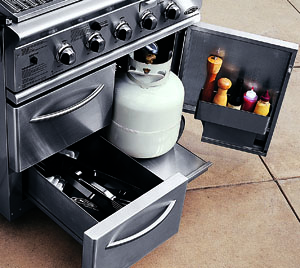 Side shelves provide convenient space for placing food and utensils next to the grilling surface. A sturdy rotisserie adds the ability to cook whole poultry and roasts. Side burners provide a cooking surface for pans, but many grill owners prefer to use their kitchen stove’s burners and add a side shelf instead. Indeed, Consumer Reports recently found that the side burners on 26 grills tested could all boil water, but none could keep sauce at a simmer.
Other options, mainly on $1,000-plus stainless-steel models, include smokers, electric warming drawers, ceramic rotisserie burners, lights on the grilling area, griddles, simmer plates and wok rings.
Be aware: additional features often add to the size and weight of a grill without increasing cooking area. That can be a problem if your patio is small, or if you want to be able to move the grill easily.
Side shelves provide convenient space for placing food and utensils next to the grilling surface. A sturdy rotisserie adds the ability to cook whole poultry and roasts. Side burners provide a cooking surface for pans, but many grill owners prefer to use their kitchen stove’s burners and add a side shelf instead. Indeed, Consumer Reports recently found that the side burners on 26 grills tested could all boil water, but none could keep sauce at a simmer.
Other options, mainly on $1,000-plus stainless-steel models, include smokers, electric warming drawers, ceramic rotisserie burners, lights on the grilling area, griddles, simmer plates and wok rings.
Be aware: additional features often add to the size and weight of a grill without increasing cooking area. That can be a problem if your patio is small, or if you want to be able to move the grill easily.
Quality = Safety
When examining a grill, give it a vigorous shake. If it wiggles, move on. You don’t want to be cooking on an open flame with your grill wobbling and potentially toppling over. “Buying quality is buying safety because you’re dealing with propane,” Nessel says. Also, choose a grill with a good grease-drainage system. Though most grills flare up momentarily when loaded with oily foods, a removable tray that puts more distance between the fire and collected grease can prevent extended burning, as well as keep grease from dripping onto your patio. Other features to prioritize include cool grill handles (for drawers and cover) that shed heat and won’t require a potholder, and a fully-rolling cart. As for burners, look for a substantial warranty. Burners are the most frequently replaced grill part, so a burner warranty of at least 10 years indicates good quality.Grill Trends
Grill trends in Boulder County are going in opposite directions. One is toward pricey high-end models that can be part of an expensive outdoor kitchen built into custom landscape masonry. The other is toward more affordable portable grills. Over the past several years, one leading Boulder retailer has sold a decreasing number of high-end portable grills and an increasing number of models under $1,000.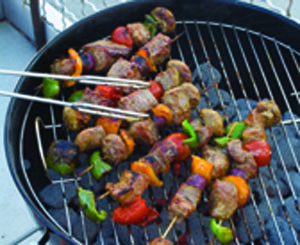 According to Consumer Reports’ tests, you probably need to spend at least $200 to $500 to get a quality grill. Spending more may get you stainless-steel styling and a few conveniences, but not always improved performance.
Smaller, portable grills also adapt well to Boulder’s climate. When the weather is harsh, Smith wheels her grill into the garage (though you can grill year-round if you cover your grill when it’s not in use). When days turn balmy, she rolls it out for a tasty meal with family and friends. “It just makes the party bigger,” she says.
Ty Wyant is former associate editor of Boulder County Home & Garden Magazine and says his Ducane grill serves him well at his new home in New Mexico.
According to Consumer Reports’ tests, you probably need to spend at least $200 to $500 to get a quality grill. Spending more may get you stainless-steel styling and a few conveniences, but not always improved performance.
Smaller, portable grills also adapt well to Boulder’s climate. When the weather is harsh, Smith wheels her grill into the garage (though you can grill year-round if you cover your grill when it’s not in use). When days turn balmy, she rolls it out for a tasty meal with family and friends. “It just makes the party bigger,” she says.
Ty Wyant is former associate editor of Boulder County Home & Garden Magazine and says his Ducane grill serves him well at his new home in New Mexico. 

